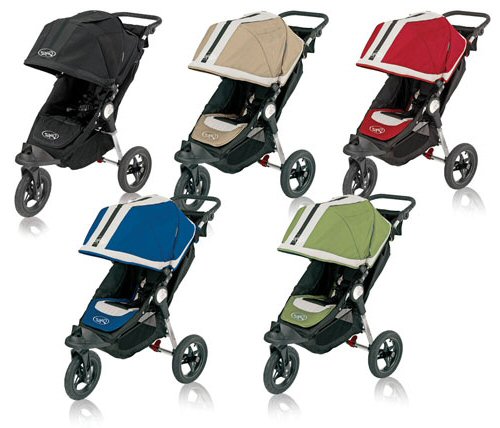Choosing Jogging Strollers
 The American College of Sports Medicine emphasizes the importance of using a jogging stroller safely. This stroller checklist will help keep your child safe during your morning run.
The American College of Sports Medicine emphasizes the importance of using a jogging stroller safely. This stroller checklist will help keep your child safe during your morning run.
Since jogging strollers were first developed in 1983, their popularity among parents has increased dramatically. Today there are jogging strollers in a variety of shapes and sizes to match almost anyone’s needs, including parents with twins or children with physical disabilities. Jogging strollers continue to be very popular choices among parents who decide that regular exercise is an important part of their lives. Parents may benefit from a healthy lifestyle and enjoy exercising with their children.
All jogging strollers should have standard safety features such as a deep seat with seat belt, a locking brake, and a safety wrist strap. These standard safety features are essential. There are other aspects of safety and use that the parent must keep in mind.
Use the parking brake when helping your child into and out of the stroller.
Use the stroller only for walking or jogging, and not with skates or rollerblades, because stopping is difficult without the full use of both feet.
Steering with the strollers can be a challenge and a wide gentle arc should be used to turn.
Always use the wrist strap to prevent the stroller from breaking free.
Proper attention should be paid to your child’s comfort and safety before and during exercise. The walker’s or jogger’s temperature rises during exercise but the child’s body temperature stays the same or can actually fall if you’re running or walking into the wind, especially on cold days. Be sure to dress your child appropriately. Use a light blanket or towel fastened by clothes pins to the canopy to protect your child when needed. Remind older children it is dangerous to put their hands and feet near the wheels or spokes, to climb out of a moving stroller, and to unfasten the seat belt.
There are many strollers to choose from on the market, and a good way to find the stroller best for you is to call your local bicycle shops and take one for a tryout. The American College of Sports Medicine recommends that you look for the following features when purchasing a jogging stroller:
Most models are all-terrain, but some handle uneven surfaces better than others. Those with
larger (20″) wheels and pneumatic (air-filled) tires provide the best shock absorption.
Make sure that the model folds easily for transport in car or for storage at home. Some strollers have detachable wheels that make storage easier.
The lighter the stroller, the more you will enjoy pushing it.
The seat varies between models from plastic to machine-washable fabric. Some have deeper, wider seats for larger children and padded frames in the seating area.
Other features to consider are whether the jogging stroller has a handle that can be adjusted to suit the height of the walker/jogger, whether the stroller comes with a sun and/or rain canopy or carrying pouch, and whether the stroller can be expanded to include another seat.

